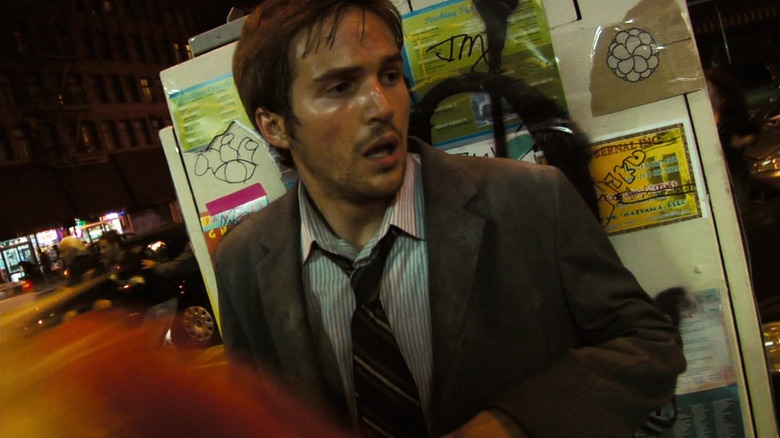Cloverfield's Physically Demanding Scenes Required Oxygen Tanks On Set
In Matt Reeves' "Cloverfield," the streets of Manhattan are terrorized by a giant monster that seems un-killable, given the massive scale and strength it boasts. No, this is not Godzilla rampaging across a city or tearing down skyscrapers, but the effect is still rather chilling, thanks to the bleak, quasi-apocalyptic world Reeves creates in the film. To simply call "Cloverfield" a tense creature feature would indeed be a misnomer — while consisting of all the hallmarks of a monster movie, it also uses found footage to resurrect the horrors of the past, which claimed the lives of those who did not live to tell the tale. The footage survives, however, functioning as a reminder that a new, unpredictable threat lurks around the corners of the world, capable of wreaking greater havoc and wiping out humanity as we know it.
Reeves, along with J.J. Abrams (who produced the film), wanted to capture the grounded reality of such a sudden catastrophic event upending everyday lives. Our protagonist Rob Hawkins (Michael Stahl-David) is definitely no hero — at no point does he intend to take on the monster head-on or come up with a clever plan to defeat it, as his motivation throughout is to help save his loved ones and survive. Rob is just some dude whose dreams of normalcy are crushed by the appearance of a ginormous monster stomping Manhattan. Given how bleak the ending is, good survival instincts are not enough in a world so nihilistic as the one in "Cloverfield."
As the primary characters in the film are perpetually faced with dangerous, stressful scenarios, filming some of these scenes turned out to be unsurprisingly demanding. Indeed, the "Cloverfield" cast hasn't held back about the physical challenges that came with running around a city with dust and debris flying all around them.
Constant running, constant screaming
Right after Rob's farewell party is disrupted and he and his friends are alerted to the first wave of monster attacks, they have no choice but to run from one point to another. His best friend Hud (T.J. Miller) and a few other pals stick with him after Rob decides to go against the crowd to rescue his love interest Beth (Odette Yustman), and the process is more harrowing than they anticipate.
After the creature's enormous tail kills dozens with a single smack, the gang is forced to sprint for their lives so as to evade instant death at every turn. Moreover, it doesn't help that the small parasitic creatures falling from the monster's body constantly attack passers-by, exposing everyone to the possibility of getting bitten. Lizzy Caplan, who plays Rob's friend, Marlena, told The Muse (via The Daily Free Press) about the physically demanding nature of shooting such intense scenes:
"We had to do upwards of 40 takes for every scene and were running a lot of the time covered in sticky blood and dirt. [...] In order to gear up for scenes when we had to be out of breath, we would run up and down the street so it would actually seem like we were. They actually had oxygen tanks on the set from all the dust that was always flying around."
As Matt Reeves took an incredibly realistic approach to "Cloverfield," it makes sense for the cast to simulate breathlessness in certain scenes, adding authenticity to the horrifying nature of the camcorder footage uncovered years later by the U.S. Department of Defense in the film. Apart from being a personal record of Rob's final moments, the footage doubles as historical evidence of the catastrophic event that changed the world.
Filming an apocalypse
Rob, whose sole objective is to rescue Beth after Manhattan is attacked, desperately searches for a way to reach Time Warner Center (where Beth is trapped). Hud, who was responsible for filming testimonials during Rob's farewell party earlier that night, puts the camcorder to good use by recording everything that happens after the first oil tanker explosion. This narrative decision allows the events to evoke a gritty, grim quality while letting the footage itself convey the gravity of the Cloverfield disasters, where mysterious creatures attack Earth and put humanity at risk.
T.J. Miller told The Muse about the challenges of filming while holding a bulky camera, especially in scenes that required a whole lot of running and screaming, which added to the "very demanding" nature of the "Cloverfield" shoot:
"We spent 12 hours a day on the set sometimes and I was holding the camera a lot, which was difficult. It was not a tiny camera, although it seemed like it. It was pretty big. Just constantly running, constantly screaming, and always breathing hard — even in the sound booths off the set — made the movie very demanding to film."
While "Cloverfield" warranted some intense commitment from its cast and crew, the risks taken ultimately paid off. Matt Reeves succeeded in crafting an emotionally-resonant monster film that underlined the fleeting nature of relationships while offering genuinely thrilling scares of the sci-fi variety. Even among the three entries in the "Cloverfield" franchise, Reeves' original chapter emerges as an anomaly, serving as a reminder about the necessity of high-risk-high-reward creative projects that can reinvigorate hackneyed genre tropes and conventions. Just like the mysterious kaiju at its center, "Cloverfield" burst into the scene and elevated the stakes of what a good creature-focused disaster flick should be like.


